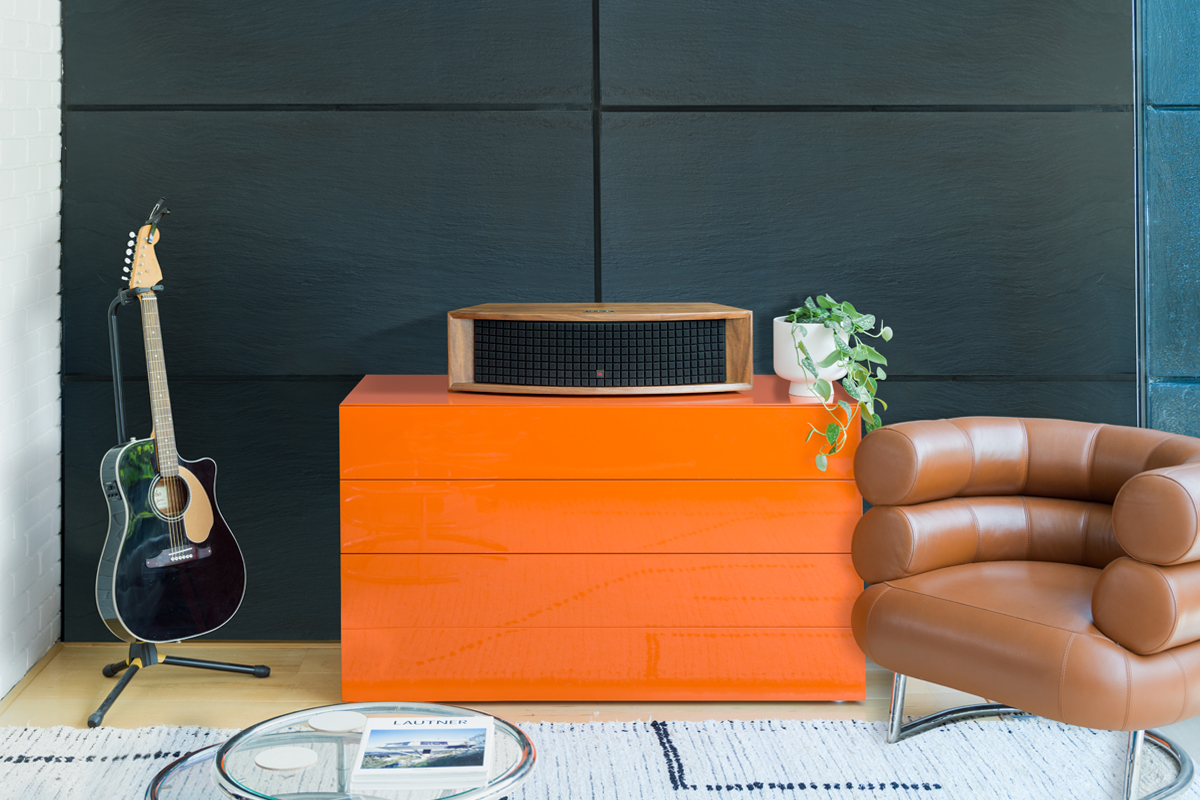 Nostalgia is huge in hi-fi right now. Just look at all those retro-styled speakers from brands like JBL, KLH, Klipsch, Mission, PSB, and Wharfedale. JBL, for instance, offers standmount speakers that evoke the legendary L100, which made its debut in 1970. Like the original L100, the L52 Classic ($1000/pair, all prices in USD unless noted otherwise), L82 Classic ($2750/pair), and L100 Classic ($4400/pair) all feature walnut veneer enclosures and JBL’s iconic Quadrex foam grilles.
Nostalgia is huge in hi-fi right now. Just look at all those retro-styled speakers from brands like JBL, KLH, Klipsch, Mission, PSB, and Wharfedale. JBL, for instance, offers standmount speakers that evoke the legendary L100, which made its debut in 1970. Like the original L100, the L52 Classic ($1000/pair, all prices in USD unless noted otherwise), L82 Classic ($2750/pair), and L100 Classic ($4400/pair) all feature walnut veneer enclosures and JBL’s iconic Quadrex foam grilles.
The same design cues are featured on JBL’s L75ms Integrated Music System ($1500). The satin walnut cabinet and removable black Quadrex foam grille aren’t the only retro touches. The front baffle arches outward, much like the horn waveguides on JBL’s flagship floorstanding speakers. The L75ms looks like a music system that can make some serious noise.
Under the vintage exterior is a thoroughly modern piece of kit. The L75ms has ethernet, Wi-Fi, and Bluetooth connectivity, and a network streamer that supports Apple AirPlay 2, Google Chromecast, Spotify Connect, Tidal Connect, and UPnP/DLNA. The player also has MM phono, HDMI ARC, and 3.5mm auxiliary inputs.
Inside and out
With maximum dimensions of around 31″W × 8.5″H × 11″D and weighing in at 35 pounds, the L75ms is the biggest tabletop music system I’ve ever come across. This thing is a monster—you need a large surface to accommodate it.
Removing the Quadrex grille reveals an unusual driver complement. On either side of the front baffle is a 5.25″ pulp-cone woofer powered by an amplifier rated at 125W RMS and a waveguided 1″ aluminum-dome tweeter powered by an amplifier rated at 25W RMS. In the center is a single 4″ pulp-cone midrange driver powered by an amplifier specified to output 50W RMS.
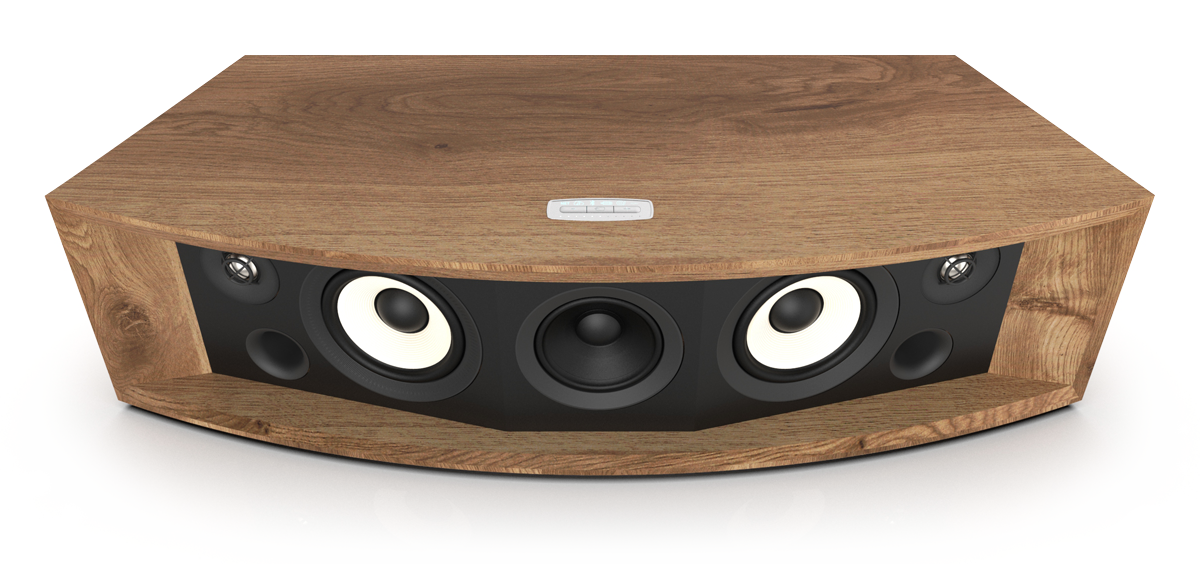
The L75ms is a two-way, front-ported design, with a DSP-based, fourth-order Linkwitz-Riley crossover centered on 2.5kHz between the woofer and tweeter. Operating independently of the woofers and tweeters, the midrange driver receives a summed mono signal, reduced in level and bandpass-filtered between 200Hz and 7kHz. It functions as a center-fill channel, keeping vocals and dialog focused in the center when the JBL’s Soundfield Expander (SFX) feature is engaged. As I’ll describe in the Listening section, SFX dramatically broadens the soundstage thrown by this one-piece player.
On the far right of the jack panel on the back is a master on/off switch, and below it a two-prong power inlet. To the left is an HDMI ARC port for connection to an HDTV, a pair of RCA jacks and ground post for connecting a turntable, a 3.5mm stereo line-level analog input, and an RCA subwoofer output.
The sub output is not low-pass filtered. To implement a low-pass filter, you use the crossover control on the subwoofer itself. However, the L75ms senses when a subwoofer is connected and automatically implements a high-pass filter for the built-in speakers. This frees the JBL’s woofers from having to produce deep bass, which results in lower distortion and compression, and better clarity in the upper bass and midrange.
Further to the left of the jack panel is a two-position Bass Contour slider control with 0dB and -3dB positions—the -3dB setting is used when the L75ms is installed inside a cabinet or bookcase, or very close to a wall.
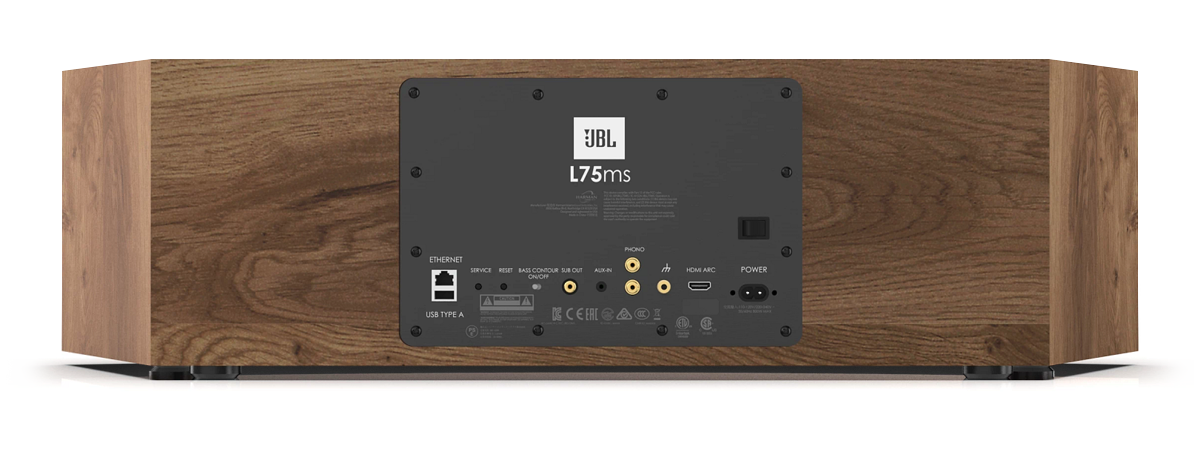
On the far left is an ethernet port and below it a USB Type-A port for service—the USB port can also be used for charging a mobile device. To their right are small buttons for applying a service update and performing a factory reset.
The top panel has buttons for lowering and raising volume, and for cycling through sources. LED indictors above those buttons confirm that the L75ms is connected to your network and show the selected source.
A simple RF remote is included with the L75ms. At the top are on/off and mute buttons, and below these a circular pad with volume-control, track-skipping, and play/pause functions. Two rows of three buttons each below the pad are used for selecting sources and toggling SFX processing.
Setup and software
The L75ms comes with a rudimentary Quick Start Guide. I did not see a full manual online. No matter—the Quick Start Guide should be enough to get most users up and running. The first step is to pair the remote with the player. The second is to connect the player to your home network. If you’re using a hardwired connection, all you have to do is run a network cable between the JBL speaker’s ethernet port and your router. To connect via Wi-Fi, you use the Google Home app on an Android or iOS device.
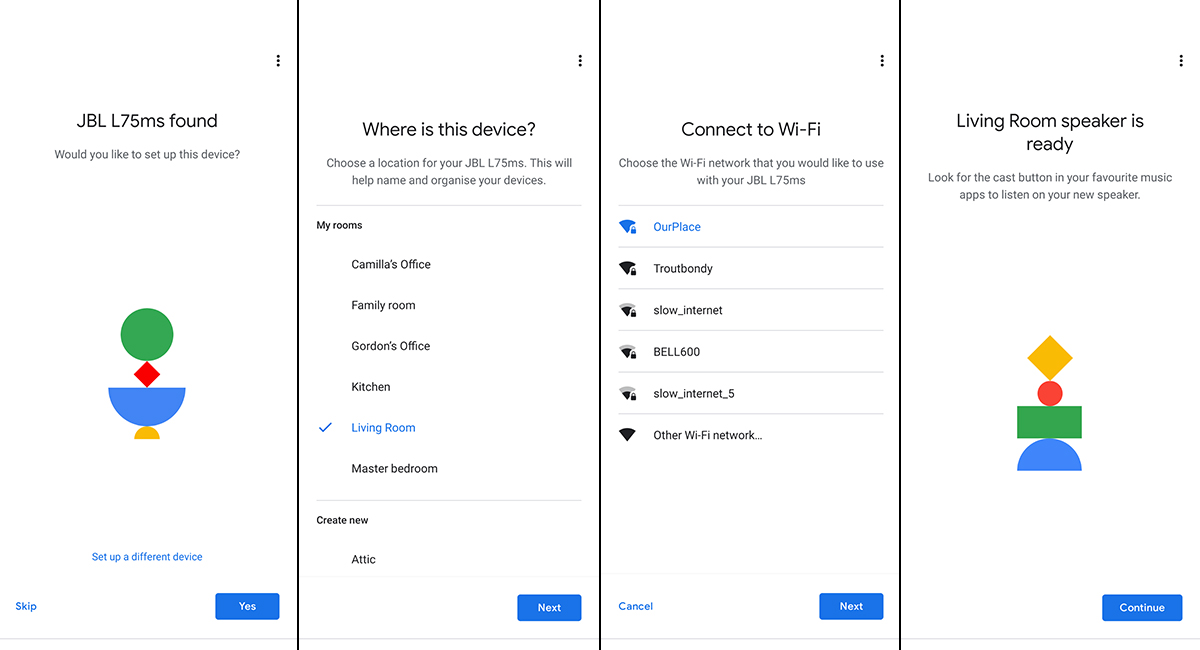
After launching Google Home on my Pixel 4a 5G smartphone, the app found the L75ms and asked if I wanted to set it up. After I specified the room where I was using the player, the app displayed a list of available Wi-Fi networks; and when I selected mine, the app asked if I wanted to use the saved password. Voilà—I was connected. Google Home then updated the player’s firmware, and I was done. Piece of cake.
Via ethernet and Wi-Fi, the L75ms can receive hi-rez audio up to 32-bit/192kHz. There are many ways to stream music to the JBL speaker. As noted, the player supports Apple AirPlay 2, for CD-resolution streaming from Macs and iOS devices. It also features Google’s Chromecast Built-in, so it can receive audio at up to 24/96 resolution from any Cast-enabled app. You can also stream from any UPnP-capable app, such as Audirvana on a PC or Mac, or mConnect on an Android device. Another option is MusicLife, a UPnP player app from Harman, JBL’s parent company. Spotify Connect and Tidal Connect are also supported, so you can select music in the apps for those services, then transfer playback to the L75ms. Roon Ready certification is pending, but that had not yet happened during my review period.
Listening
For this review, I placed the L75ms on the mantle of the electric fireplace in the living room of our Toronto home. Its rear panel was 6″ from the front wall, and its front baffle was 7′ from the sweet spot on the end cushion of the sectional sofa on the opposite wall. I did most of my listening from there, but the L75ms worked well for casual listening as I wandered about the room. With the speaker placed so close to the wall, I set the Bass Contour switch in the -3dB position. This setting was effective. Throughout my listening, bass was deep and robust, but well controlled.
I started with some vinyl, connecting my Pro-Ject Debut Carbon Evo turntable ($869 CAD with Ortofon 2M Red cartridge) to the JBL’s phono input. With my ear 12″ from the speaker, and the volume control set at a comfortable but room-filling listening level, I heard faint noise and hiss from the L75ms when no music was playing. Further away, noise was inaudible.
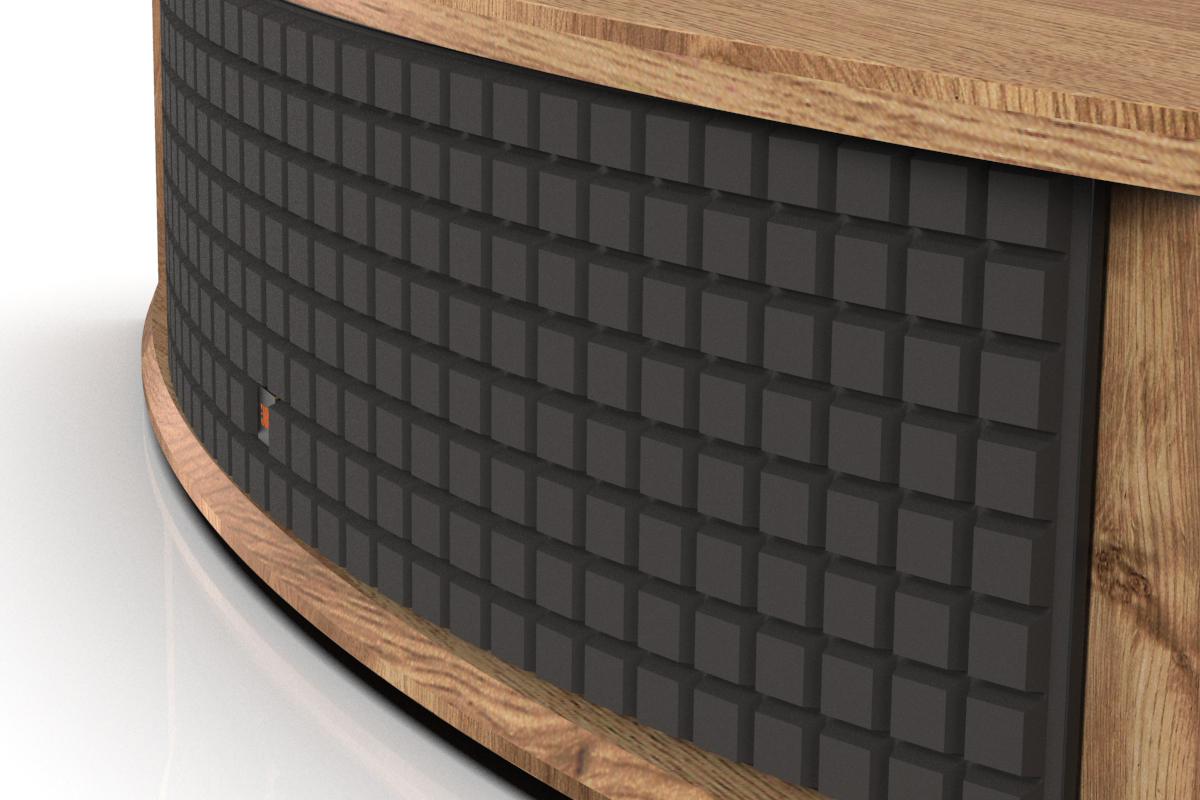
I loved the way the JBL L75ms rendered Leonard Cohen’s voice on “Happens to the Heart,” from his extraordinary Thanks for the Dance (LP, Sony Music 19075978661). This posthumous album features Cohen singing and reciting his lyrics, which were later set to music by his son, Adam. Through the L75ms, the elder Cohen’s deep baritone, centered in the soundstage, sounded full and expressive but not chesty. It was completely natural, with deep fundamentals, and a slight rasp on top that conveyed his age and infirmity. Enunciation was excellent, but not spitty or exaggerated. The L75ms made it easy to appreciate the expressive nuances in Cohen’s delivery—the way he draws out some vowels and descends to whispers in some phrases.
With the SFX feature engaged, the soundstage was surprisingly wide for an all-in-one music player, extending about 3′ beyond the L75ms on either side. However, the soundstage was not particularly deep—everything was on the same plane as the speaker. Switching SFX on and off while listening to this song, it was clear that SFX had no effect other than widening the soundstage; it introduced no artifacts. SFX just made the presentation more immersive, so I left the feature on throughout my testing.
The tonalities of the instruments were excellent. Javier Mas’s plucks on laúd were fast and precise, and segued into rich, woody resonance. Michael Chaves’s deep notes on bass guitar, providing a rock-solid foundation for the music, were well defined but not exaggerated, and were followed by extended decays, with excellent pitch definition. There was no hint of boominess.
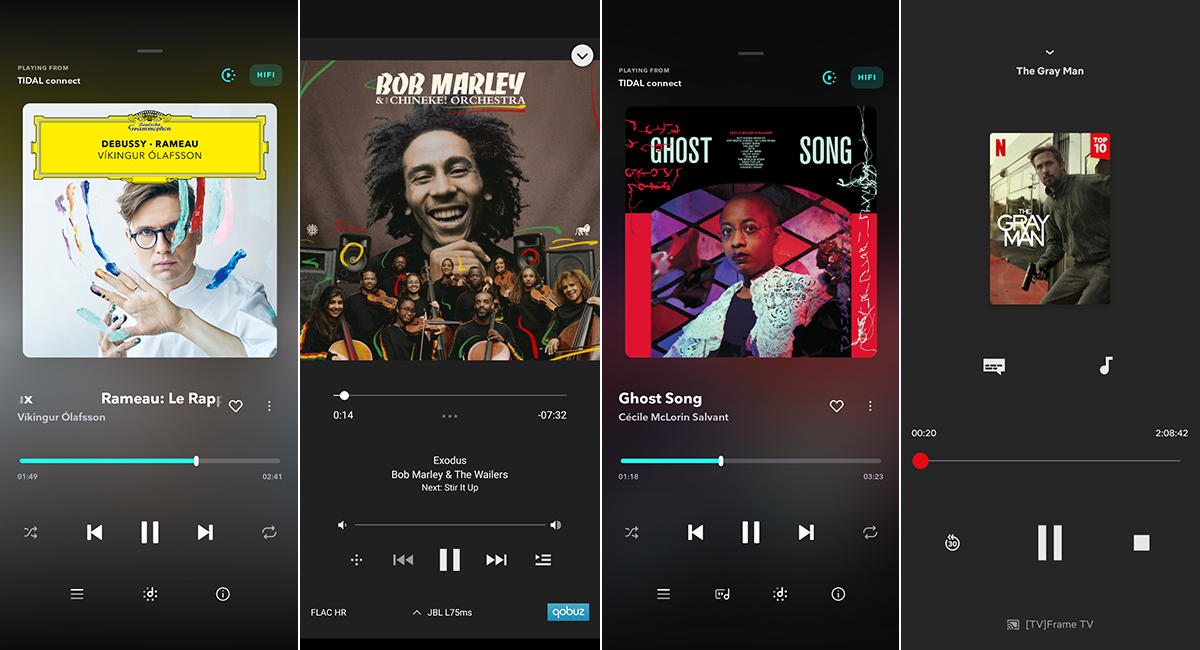
Cécile McLorin Salvant’s unaccompanied soprano voice jumped out of the L75ms at the beginning of the title track from Ghost Song (16/44.1 FLAC, Nonesuch Records / Tidal), as she wailed, “I tried to keep our love going strong / But no matter how hard I tried, something went wrong.” It was completely riveting. The presentation of the JBL speaker was just as affecting in the tender choruses, when Salvant sings, “I’ll dance with the ghost of our love / I will dance with the ghost of our long-lost love.” In the restrained and intense passages alike, vocal timbres were totally convincing—I heard no coloration whatsoever. Her consonants were precise, but never hot or spitty.
With SFX processing enabled, the L75ms created a very wide soundstage. Location of aural images was commendably precise, with Salvant’s vocals locked in the center, and her overdubbed harmonizing in the choruses, along with Sullivan Fortner’s voice, just off to the sides. Marvin Sewell’s bluesy electric-guitar riffs emerged from a space just to the left of the JBL speaker, and his acoustic-guitar chords from the right. Swirling around the center were Fortner’s piano and Fender Rhodes, their notes seemingly coming out of the ether. Burniss Travis’s electric bass and Keita Ogawa’s kick drum and snare beats, giving the song its heartbeat, were big and robust, and not the least bit bloated. The L75ms separated all these elements nicely—the sound was never compressed or congested.
Next up was a performance of Jean-Philippe Rameau’s “Le Rappel des oiseaux” (“Dialog of the Birds”) by the Icelandic pianist Víkingur Ólafsson from his album Debussy—Rameau (16/44.1 FLAC, Deutsche Grammophon / Tidal). The L75ms did full justice to Ólafsson’s subtle dynamic shading and creative pedaling. His gentle attacks mimicking the back-and-forth birdcalls were fast and precise, but not at all overdone, and segued beautifully into the resonance of the piano’s soundbox and then to the reverberant acoustic of the hall where the recording was made. With SFX engaged, the soundstage was vast, extending several feet beyond the outer boundaries of the system itself. The tonality of Ólafsson’s Steinway piano was very convincing, and consistent throughout its entire range.
To see how the L75ms would deal with something more rambunctious, I cued up “Exodus” from Bob Marley & The Chineke! Orchestra (24/96 FLAC, Island Records / Qobuz) in the MusicLife app and activated the JBL speaker’s SFX processing. Recorded at Abbey Road Studios, this new album features ten of Marley’s greatest songs with added accompaniment from the Chineke! Orchestra, a London-based ensemble of ethnically diverse musicians.
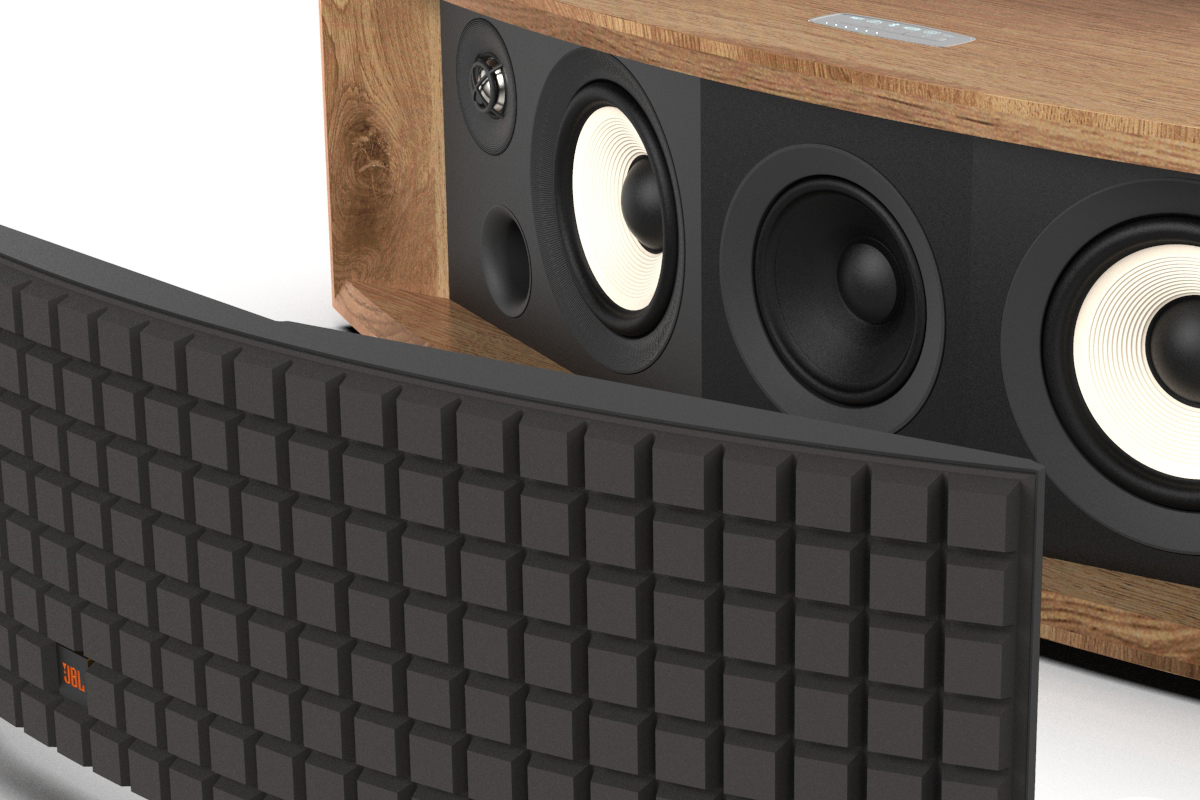
Wrapped in reverb, the Chineke! strings extended far beyond the JBL speaker’s outer edges, creating a dancehall atmosphere. The sound of Marley and his bandmates was more focused on the player itself, with Marley’s voice in the center, the backup singers all around him, the guitars on the left, and the horns, bass, drums, and percussion a little further back. I would have liked a bit more oomph from Aston “Family Man” Barrett’s Fender Jazz bass, Alvin “Seeco” Patterson’s percussion, and Carlton “Carly” Barrett’s drums; but, for an all-in-one tabletop system with 5.25″ woofers, what the L75ms did with this track was pretty amazing.
Then I remembered that subwoofer output. I connected my SVS 3000 Micro subwoofer ($899.99), and set the 3000 Micro’s low-pass filter to 90Hz with the companion SVS app. I played test tones at various frequencies and adjusted the subwoofer’s level control to match the output of the L75ms. A great feature of this little subwoofer is the ability to apply parametric EQ: I enabled two filters that address some serious standing waves in my listening environment. Now it was time to play that track again.
With the sub in the mix, Family Man’s Fender Jazz bass pounded harder, and the drums and percussion had more impact—exactly what I was hoping for. Not only was the bottom end more powerful, it was tighter as well. The improvements higher in the audioband were just as dramatic. The sound of the Wailers’ instruments was less congested, so I could hear the horns and the two electric guitars—one slamming a hard reggae beat, the other playing wah-wah accents—more clearly. Dynamics were also improved with the sub doing the heavy lifting in the bass, and midrange sounds were less edgy. Without the sub, mids had a slightly hard edge.
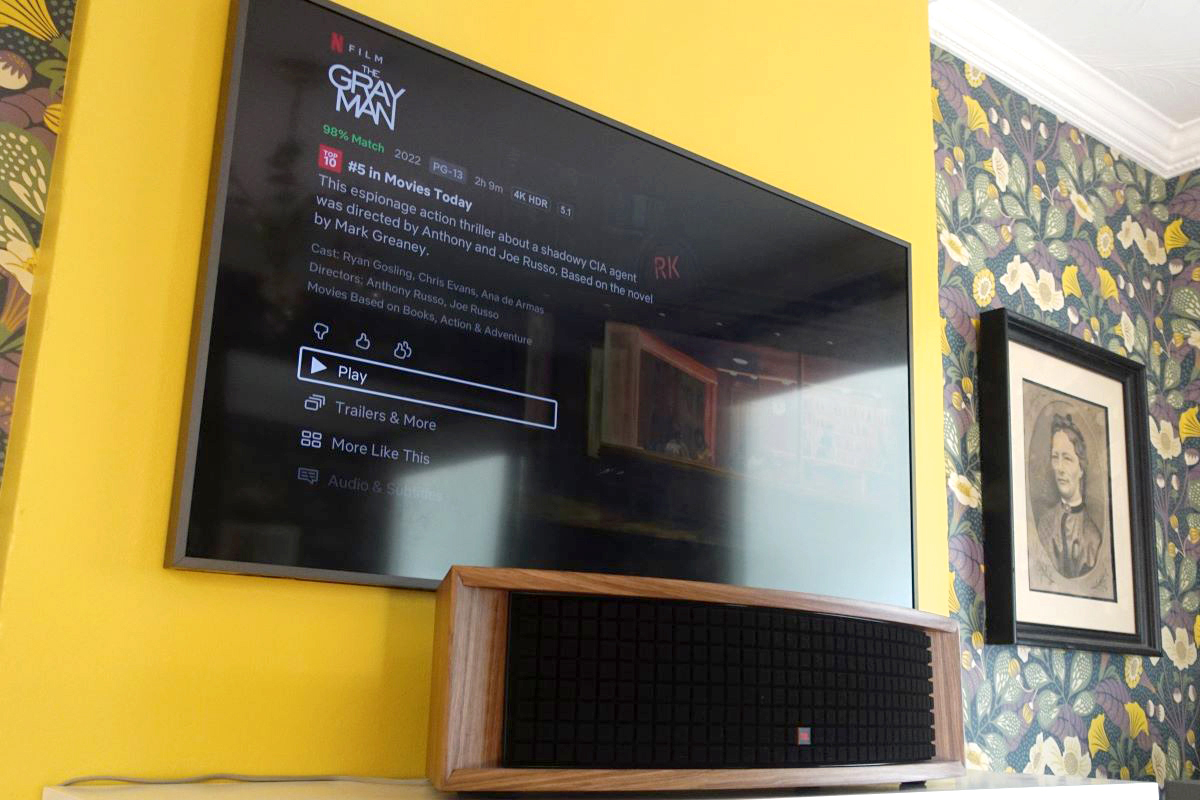
To assess the prowess of the L75ms with movies, I connected the JBL speaker’s HDMI ARC input to the HDMI ARC port on the One Connect breakout box for my Samsung Frame TV, which is mounted on the wall above our mantle. The Frame TV recognized the L75ms as an HDMI receiver. After I selected it as the output device for TV audio, the L75ms automatically switched to the HDMI input when I began playing anything on the TV. I could control the volume of the JBL speaker with the TV remote.
Figuring a big, inane action flick would be a good test for the L75ms, I streamed The Gray Man from Netflix to the Frame TV. Featuring Ryan Gosling as a CIA assassin on the run from a psychopathic killer, The Gray Man has oodles of explosions, car crashes, and gun battles. The JBL all-in-one proved surprisingly adept in challenging scenes like the shootout in the square in front of the Prague Opera House. With SFX engaged, the sound of the music soundtrack extended several feet beyond the JBL speaker’s outer edges. The pounding timpani beats were deep and robust. While gunshots and explosions didn’t sound as powerful as they would have through full-sized speakers, they were nonetheless impressive, with none of that tearing, edgy sound you get with mass-market soundbars. Throughout the scene, dialog remained tied to the center of the screen, and always sounded intelligible and natural.

Adding in the SVS subwoofer made a marked improvement. Bass was deeper, tauter, and more impactful. Explosions were more powerful, as were the pounding timpani in the musical soundtrack. Dynamics were less compressed. But playing the same scene without the sub made me realize that the L75ms is pretty impressive on its own.
Comparison
I compared the JBL L75ms with another luxury music player, Sonus Faber’s Omnia ($1999). Like the L75ms, the Omnia has phono and HDMI ARC inputs, and a built-in streamer that supports AirPlay 2, Chromecast, Spotify Connect, and Tidal Connect. Both players have effective spatial expansion features. I engaged the Omnia’s Crescendo processing and selected the Near the Wall setting. Similarly, for the L75ms, I enabled the SFX feature and left the Bass Contour switch in the -3dB position.
Playing the LP version of Leonard Cohen’s “Happens to the Heart,” I preferred the way the JBL rendered Cohen’s voice. Through the Omnia it had a very slight chesty coloration that I didn’t hear on the JBL, and consonants had a bit of a hard edge. The soundstage thrown by the Omnia wasn’t quite as wide, but had more height and depth. Overall, I found the JBL’s spatial presentation more immersive. Microdetail was marginally better on the Omnia—I heard a little more texture in Michael Chaves’s acoustic-guitar phrases and Rob Humphrey’s taps on the snare drum. But macrodynamics were better on the JBL speaker—it sounded faster and more effortless. The violins, viola, cello, and double bass all sounded a little richer and woodier through the L75ms.
On the Rameau recording, the sound of Víkingur Ólafsson’s Steinway was just a tad clangier through the Omnia; piano tone was fuller and warmer through the JBL. Both players were wonderfully articulate, rendering Ólafsson’s playful runs, gentle attacks, and creative pedaling beautifully. But the sound of the piano reverberating through the concert hall was a little more convincing with the L75ms. With Crescendo processing, the soundstage thrown by the Omnia was higher than the JBL’s with SFX, but not as wide. Again, the presentation was more immersive through the L75ms.
Conclusion
Today, buyers looking for a premium all-in-one streaming music system are spoiled for choice. Besides Sonus Faber’s gorgeous Omnia, there’s Bowers & Wilkins’s iconic Zeppelin wireless speaker ($799), Naim Audio’s stunning Mu-so 2nd Generation ($1799), which won a SoundStage! Network Product of the Year Award in 2019, and now this wonderful player from JBL.
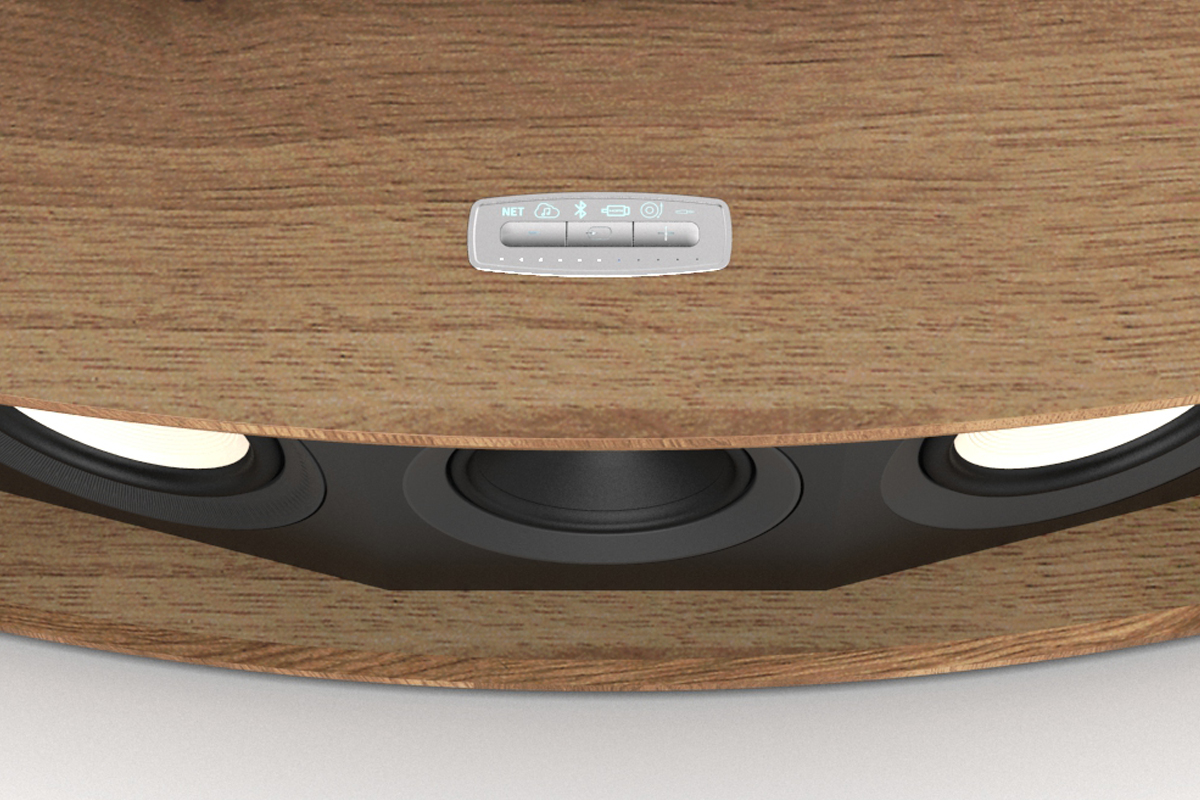
Everybody I know who’s seen the JBL L75ms Integrated Music System has been wowed by the retro design. Time and again, people told me that it’s one of the coolest-looking audio products they’ve ever seen. True to its styling, the L75ms can indeed make some serious noise. Not just serious noise, but glorious noise. This is a great-sounding music player.
. . . Gordon Brockhouse
Associated Equipment
- Music player: Sonus Faber Omnia.
- Sources and control devices: Pro-Ject Debut Carbon Evo turntable with Ortofon 2M Red cartridge; Samsung UN55LS003 55″ UHD TV “The Frame,” Apple Mac Mini computer running Roon Core 1.8; HP Spectre x360 notebook computer running Roon 1.8 and Audirvana 3.5.51, Google Pixel 4a 5G smartphone.
- Subwoofer: SVS 3000 Micro.
- Network: Google Wifi four-node mesh network.
JBL L75ms Integrated Music System
Price: $1500.
Warranty: Five years, parts and labor.
JBL
Harman International Industries Inc.
8500 Balboa Boulevard
Northridge, CA 91329
Phone: (800) 336-4525
Website: www.jbl.com





